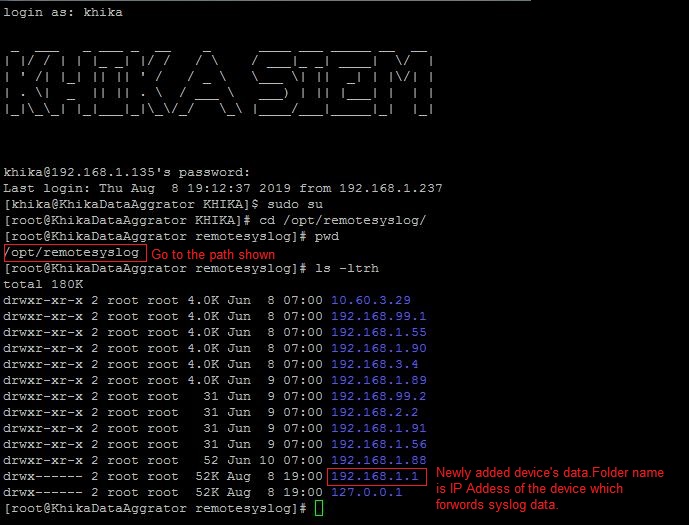FAQs
Contents
- 1 How to check if raw syslog data is received in the system? What if it is not received?
- 2 Why can’t I see any raw data on Discover Screen?
- 3 How to select data related to a particular device on your Dashboard?
- 4 How do I estimate my per day data?
- 5 SMTP settings in KHIKA
- 6 Dealing with Syslog Device in KHIKA
- 7 Dealing with Ossec Device in KHIKA
- 8 KHIKA Disk Management and Issues
- 8.1 Size of indexes representing raw logs grows too much
- 8.2 Log files of KHIKA processes does not get deleted
- 8.3 Postgres database size get increases
- 8.4 Report's files does not get archived
- 8.5 Raw log files does not get archive and deleted for ossec and syslog device
- 8.6 Cold/Offline storage partition gets full or unmounted
- 8.7 Elasticsearch snapshot archival utility not working properly
- 9 Elasticsearch Snapshot functionality configuration
- 10 Check Status of Snapshot / Restore Functionality
How to check if raw syslog data is received in the system? What if it is not received?
In the section for adding data of syslog based devices we have explained how to enable syslog forwarding on the the data sources first and then add that device into KHIKA. When we add a device successfully, we can see the device entry in the “List of Devices” tab. (For this, go to Configure – Adapter – Manage Devices next to that Adapter.)
However if raw syslogs are not received from that device, we get an error while adding the device.
It is recommended to wait for upto 10 minutes before checking its data. To check whether we are receiving this device’s data in KHIKA, go to “Discover” screen from the left menu. Search for the IP address of the device in the search textbox on the top of the screen.
In our example from the image, IP address is “10.2.5.6”. In the search bar in the Discover screen, just enter “10.2.5.6”. This is for showing up any and all data relevant to the device with this IP.
If you can see data for this IP address, the logs are being received into KHIKA successfully.
If not, please check section for adding data of syslog based devices. Both the steps – adding a device in KHIKA as well as forwarding syslogs from that device to KHIKA should be verified again.
Why can’t I see any raw data on Discover Screen?
On the Discover screen, you have to choose 2 things to bring up your data :
- Time duration
- Index pattern
Select the required index pattern from the dropdown on the left of the Discover Screen. This selects your data type and whether it is “raw” or calculated “rpt” data. Refer section for help on changing index
Then select the time duration of data you want to see from the time picker functionality on top right. Selecting time window is explained here
If time duration is selected too large, it may severely affect the performance of MARS. We recommend not selecting the data beyond Last 24 hours. Your searches may time out if you select large Time Ranges.
Reduce your time window and try again. It is advised to keep a lesser time window. However on the contrary, if there is no / very less data in the picked time window, you might want to increase your time window from the time picker and load the screen again.
Every dashboard in KHIKA will have multiple devices' data in it. For example, a linux logon dashboard has information about all the linux devices in the "LINUX" workspace say. the name of the relevant workspace is appears before the name of the dashboard.
To see data on the dashboard for only one linux device, you have to select the required device on your Dashboard. There are couple of ways to select an APV on your dashboard :
- Add a filter
- Enter Search query
The following procedure is applicable to all Dashboards.
Steps for Adding a Filter
On each dashboard, there is an option, “Add a filter”. Click on the “+” sign to add a new one. Use the simple drop downs in combination, to create your logical filter query.
faq3.1
faq3.2
The first dropdown is the list of fields from our data. We have selected “server_ip” here. The second dropdown is a logical connector. We have selected “is” in this dropdown. The third dropdown has the values of this field. We have selected one device say 10.13.1.3 here. So now, our filter query is : “server_ip is 10.13.1.3”
Click on Save at the bottom of this filter pop up.
Your Dashboard now shows data for only the selected device in all the pie charts, bar graphs and summary table – everywhere in the dashboard.
The applied filter is seen on top.
faq3.3
To remove the filter, hover on the filter icon on top (selected in red in above figure). Icons appear. Click on the bin icon ifaq3.1 to remove the filter. The Dashboard returns to its previous state.
faq3.4
Please Note : If this is just a single search event, donot follow further steps. If you want to save this search for this particular device with the Dashboard, follow steps given further to save the search.
Click on Edit link on the top right of the Dashboard – Save link appears. Click on Save to save this search query with the dashboard.
faq3.5
The filter currently applied shall continue to be seen on top of your Dashboard. You can remove this filter at any point of time in the future by clicking on the bin icon on your dashboard – as already explained.
Steps to Search and Save
On the top of the Dashboard, there is a text box for search. Enter your device search query for a particular device in this box.
faq3.6
We have entered server_ip:”10.13.1.3” . This is the syntax for server_ip equals to 10.13.1.3. Click on the rightmost search button in that textbox to search for this particular device on the dashboard.
All the elements on the Dashboard shall now reflect data for the selected device.
faq3.7
Please Note : If this is just a single search event, donot follow further steps. If you want to save this search for this particular device with the Dashboard, follow steps given further to save the search.
Click on Edit link above the search textbox – Save link appears. Click on Save to save this search query with the dashboard.
faq3.8
This shall stay with the Dashboard and will be seen every time we open the Dashboard.
To remove the search, select the search query which you can see in that textbox, remove / delete it. Click on Edit and Save the Dashboard again. It changes back to its previous state.
faq3.9
How do I estimate my per day data?
Please refer the dedicated section to calculate your per day data size in KHIKA
SMTP settings in KHIKA
We need to make SMTP settings in KHIKA so that KHIKA alerts and reports can be sent to relevant stakeholders as emails.
Please refer the dedicated section for SMTP settings
Dealing with Syslog Device in KHIKA
Syslog service is pre-configured on your KHIKA aggregator server (on UDP port 514). Syslogs are stored in /opt/remotesylog directory with IP address of the sending device as directory name for each device sending data. This way, data of each device is stored in a distinct directory and files. For example, if you are sending syslogs from your firewall which as IP of 192.168.1.1, you will see a directory with the name /opt/remotesylog/192.168.1.1 on KHIKA Data Aggregator. The files will be created in this directory with the date and time stamp <example : 2019-08-08.log>. If you do a "tail -f" on the latest file, you will see live logs coming in.
When you want to add a new device into KHIKA
1. Note the IP address of your KHIKA Data Aggregator.
2. Please refer to OEM documentation on how to enable Syslogs. We encourage you to enable the lowest level of logging so that you capture all the details. Syslog server where logs should go is IP address of your KHIKA Data Aggregator and port should be UDP 514.
For enable syslog of preconfigured apps in KHIKA click on the below link: • Symantec Antivirus • Cisco Switch • Checkpoint Firewall • Fortigate Firewall • PaloAlto Firewall • Sophos Firewall
3. Note the IP address of the device sending the logs (example 192.168.1.1)
4. Now go to KHIKA Data Aggregator and login as "khika" user and do "sudo su".
5. cd to /opt/remotesylog and do "ls -ltr" here. If you see the directory with the name of the ip of the device sending the data, you have started receiving the data in syslogs.
Data is not receiving on Syslog Server
- please wait for some time.
- Some devices such as switches, routers, etc don’t create too many syslogs.
- It depends on the activity on the device. Try doing some activities such as login and issue some commands etc. The intention is to generate some syslogs.
- Check if logs are generating and being received on KHIKA Data Aggregator in the directory "/opt/remotesylog/ip_of_device". Do ls -ltrh
- If logs are still not being received, Please check the following points.
- Check firewall settings on KHIKA Data Aggregator. Wait for some time perform some actions on the end device to generate logs and check in directory /opt/remotesylog/ip_of_device. Do "ls -ltr"
Check firewall status systemctl status firewalld If firewall status is active, then do the following commands to inactive and disable firewalld. systemctl stop firewalld systemctl disable firewalld Flush iptables sudo iptables –flush
- Check if there is any firewall between KHIKA Data Aggregator and allow communication from device to KHIKA Data Aggregator on port 514 (UDP)
- Login to KHIKA Data Aggregator and do tcpdump
sudo tcpdump -i any src <ip_of_ device> and port 514
If you see the packets being received by tcpdump, restart syslog service using command.
systemctl syslog-ng stop, Then wait for some time. systemctl syslog-ng start
Make sure you are receiving the logs in the directory /opt/remotesylog/ip_of_device Go to Started Receiving the logs only after you start receiving the logs.
Started Receiving the logs on Syslog server
Now you need to add a device from KHIKA GUI.
If the similar device of a data source has already been added to KHIKA
- Add this device to the same Adapter using following steps explained here.
- Else, check if App for this device is available with KHIKA. If the App is available, load the App and then Add device to the adapter using the steps explained here.
- Else, develop a new Adapter (and perhaps a complete App) for this data source. Please read section on how to write your own adapter on Wiki, after writing your own adapter, testing it, you can configure the adapter and then start consuming data into KHIKA. Explore the data in KHIKA using KHIKA search interface
Dealing with Ossec Device in KHIKA
Failing to add ossec based device
1. Time out Error
Check if you are getting following Error while adding the device.
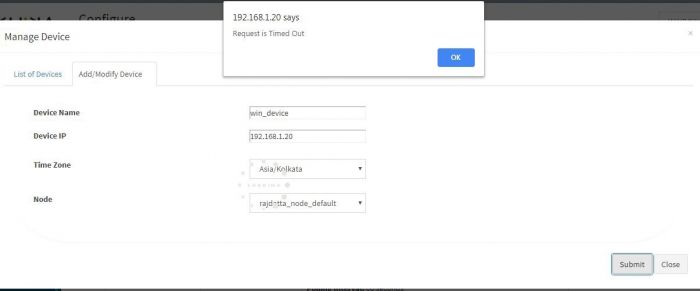
This means your aggregator is not connected to KHIKA AppServer.
Check if your aggregator is connected to KHIKA server.
1. Go to node tab in KHIKA GUI. 2. Click on Check Aggregator Status button as shown in the screenshot below
3. If it shows that the aggregator is not connected to KHIKA Server, it means that you aggregator is not connected to KHIKA AppServer.<enter link here that explains check aggregator status and solve the problem ><vrushali>
2. Device is already present
Check if you are getting the following message while adding the device
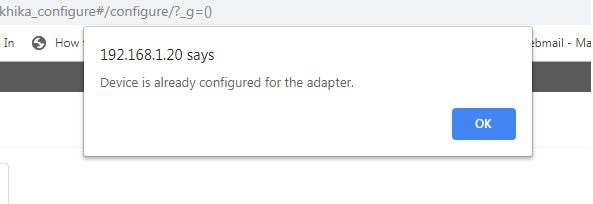
We cannot add the same device twice, Check if you already have added the device in the device list.
Ossec Agent And Ossec Server Connection issue
Ossec Server not running
There could be a problem where ossec server is stopped and is not running.
Go to node tab and click on Reload Configuration button to restart the ossec server.
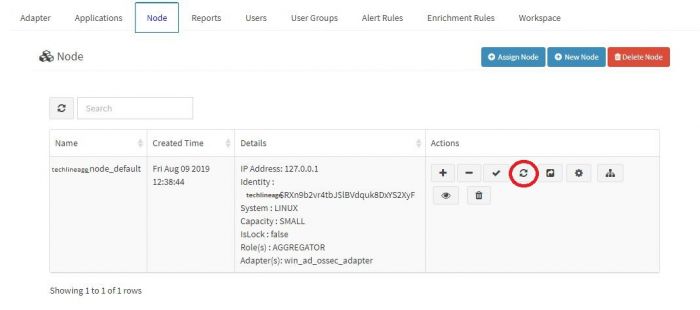
There is a firewall between the agent and the server you will find following logs
If you have the following message on the Linux agent log or Windows agent log.
Waiting for server reply (not started)
KHIKA Disk Management and Issues
In KHIKA there are generally three kinds of partitions
1. root (/) partition which generally contains appserver + data.
2. Data (/data) partition contains index data which include raw, reports and alerts.
3. Cold/Offline data (/offline) partition which is generally NFS mounted partition.
And this type of partition contains offline i.e. archival data which is not searchable.
To find out which partition is full use following commands
1. df -kh
above command will give you disk space utilization summary according to partitions.
2. du -csh * or du -csh /data
above command will give directory wise space usage summary.
Disk Full Reason
- Size of indexes, representing raw logs grows too much.
- Log files of KHIKA processes does not get deleted (log files of KHIKA processes are huge)
- Postgres database size get increases (when you store too many reports, alerts etc)
- Report's files does not get archived(Reports are CSV and are stored as separate indexes)
- Raw log files does not get archive and deleted for ossec and syslog device(ossec raw files are big, so are syslogs)
- Cold/Offline storage partition gets full or get unmounted(which means, a snapshot of hot data can't happen).
- Elasticsearch snapshot archival utility not working properly (which means, a snapshot of hot data can't happen).
Size of indexes representing raw logs grows too much
The goal is to find the index that eats up maximum space.
Find out from which data source you are getting more logs using a utility like dev tools (you need to be KHIKA Admin to access dev tools)
Use following commands to find out disk space usage accordingly indices
1. GET _cat/indices
Above command will give all indices (see below screenshot). This command will give outputs as index name, size, number of shards, its current status like green, yellow, red, etc.
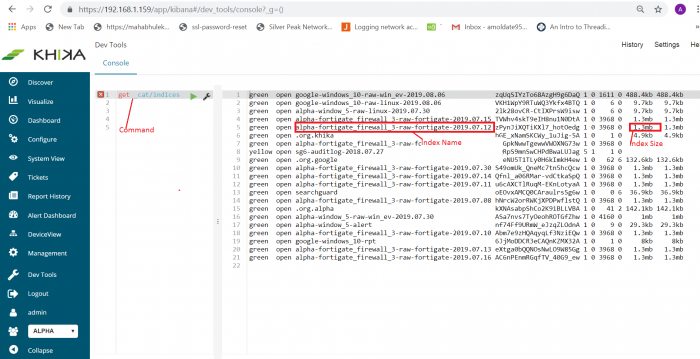
For example, if you want to find out indices only for FortiGate data source use command like
2. GET _cat/indices/*fortigate*
This command will give only FortiGate data source indices along with its name, status, size, etc. See below screenshot for reference.

If you find that disk space is utilized due to raw indices
1. Make sure that the data retention period (TTL) is reasonable. By going at workspace tab of configure page and modified it if required By going at workspace tab of configure page and modified it if required
configure -> Modify this workspace -> Data Retention -> Add required data retention ->save
2. Archive using snapshot archival utility( kindly refer steps how to configure it). Note that Archival needs space on the cold-data destination.
3. If there is no chance to free disk space then delete old large indices.Let say if you want to delete index “alpha-fortigate_firewall_3-raw-fortigate-2019.07.30” then use the following command in dev tools (You must be a KHIKA Admin )
i. POST alpha-fortigate_firewall_3-raw-fortigate-2019.07.17/_close ii. DELETE alpha-fortigate_firewall_3-raw-fortigate-2019.07.17
Log files of KHIKA processes does not get deleted
If you found process log files does not get deleted.
1. Use following command to find out disk usage of log files. Log files stored as *.log extention.
sudo find /opt/KHIKA/ -iname "*.log" -type f | grep -v kafka | xargs du -hs | sort -rh
above command will give the output of filename and it's size (see below screenshot)
2. Use command rm to remove files.
for example, to remove file “/opt/KHIKA/alertserver/log/alertserver_debug_2336.log” use below command.
rm -rf /opt/KHIKA/alertserver/log/alertserver_debug_2336.log
3. Make Sure log file clean up a cronjob is working (/opt/KHIKA/UTILS/manage_logs.sh)
to check cronjob use following command
# crontab -l, this will give output as follow.

Here clean up cron job configure for every day at 7 am
4. If any directory entry is missing from clean up cronjob then add it into "/opt/KHIKA/UTILS/manage_logs.sh"
Steps to add missing entry
• vi /opt/KHIKA/UTILS/manage_logs.sh
• Enter in insert mode by pressing “i” on keyboard.
• Add missing entry. Let say “/opt/KHIKA/collection/log” directory is missing then add it's entry to delete log file which is older than 7 days as follows
find /opt/KHIKA/collection/log -mtime +7 -delete
• Press key “Esc” to enter in command mode.
• Press key “:wq” to save and exit.
5. On aggregator node Make sure following properties is set to "false" in "/opt/KHIKA/collection/bin/Cogniyug.properties" file.
remote.dontdeletefiles = false
open file opt/KHIKA/collection/bin/Cogniyug.properties using common editor like vi/vim add property and then save and exit.
If property “remote.dontdeletefiles” is not set to “false”, Aggregator will create .out and .done file in directory “/opt/KHIKA/collection/Collection” and “/opt/KHIKA/collection/MCollection” and will never delete it. This will eat up space on aggregator. Setting property to false will delete the .out and .done files
Postgres database size get increases
Using a utility like du -csh, If you found Postgres data directory(/opt/KHIKA/pgsql/data) taking more space then find out which table taking more space using following steps
1. To execute SQL command you will need access of PostgreSQL console. To get access of PostgreSQL use following command in order
• . /opt/KHIKA/env.sh • psql -d khika_db -U khika -W • after enetring above command it will prompt for password .Enter the password
2. Use the following SQL command.
SELECT relname as "Table", pg_size_pretty(pg_total_relation_size(relid)) As "Size", pg_size_pretty(pg_total_relation_size(relid) - pg_relation_size(relid)) as "External Size" FROM pg_catalog.pg_statio_user_tables ORDER BY pg_total_relation_size(relid) DESC limit 10;
Above SQL command will return top 10 table which has more size. generally, it will return the following tables.
• collection_statistics
• collection_samples
• moving_avg_sigma
• alert_details
• and report related tables
3. Let say if you found that collection_statistics table taking more space then delete data from a table from which is less than the 2018 year and Use SQL command
delete from collection_statistics where date_hour_str <= '2018-12-31';
OR, if you want to delete from collection_samples table then use the following command
delete from collection_samples where date_string <='2018-12-31';
OR, if you want to delete data from table moving_avg_sigma then use the following command
delete from moving_avg_sigma
OR, if you want to delete data from alert_details table then use the following SQL commands. (Note: it is recommended that keep alerts data at least for three years).For example, delete before the year of 2015 then use following commands
1. delete from alert_source_device_mapping where alert_id in (select alert_id from alert_details where dtm <=( SELECT EXTRACT(epoch FROM TIMESTAMP '2015-12-31')));
2. delete from alert_device_mapping where alert_id in (select alert_id from alert_details where dtm <=( SELECT EXTRACT(epoch FROM TIMESTAMP '2015-12-31')));
3. delete from alert_status_audit where alert_id in (select alert_id from alert_details where dtm <=( SELECT EXTRACT(epoch FROM TIMESTAMP '2018-12-31')));
4. delete from alert_details where dtm <=( SELECT EXTRACT(epoch FROM TIMESTAMP '2015-12-31'));
NOTE: if you found any other tables which are not in step (2) then contact an administrator.
Report's files does not get archived
Reports CSV files get stored at location "/opt/KHIKA/appserver/reports" and "/opt/KHIKA/eserver/reports" If you found that above mentioned directories taking more space.Then do following steps
1. Make sure archival cron is configured for reports (/opt/KHIKA/UTILS/manage_logs.sh)Use following command to check cron
crontab -l
2. Make sure the following entries is present in file /opt/KHIKA/UTILS/manage_logs.sh
• find /opt/KHIKA/appserver/reports -mtime +7 -type f | xargs gzip
• find /opt/KHIKA/tserver/reports -mtime +7 -type f | xargs gzip
• find /opt/KHIKA/eserver/reports -mtime +7 -type f | xargs gzip
If above entry is missing then add it using common editor like vi or vim.
3. If reports it is too old and there is no chance to free disk space then delete the reports. Use the following commands to delete report files which are older than 1 year
• find /opt/KHIKA/appserver/reports -type f -mtime +365 -delete
• find /opt/KHIKA/tserver/reports -type f -mtime +365 -delete
• find /opt/KHIKA/eserver/reports -type f -mtime +365 -delete
Raw log files does not get archive and deleted for ossec and syslog device
On Aggregator node, Raw logs are stored at "/opt/ossec/logs/archives" for Ossec devices and "/opt/remotesyslog" for Syslog devices. On Aggregator by default we keep raw logs only for three days. If you find raw logs more than three days then delete it and configure cron job for the same. Add following cronjob "/opt/KHIKA/UTILS/manage_rawdata_logs.sh"
Steps to add a cronjob
1. login as user khika on KHIKA Aggregator server. 2. Enter crontab -e command. 3. Add following entry “* */2 * * * /opt/KHIKA/UTILS/manage_rawdata_logs.sh >/dev/null 2>&1” to run cronjob every 2 hour.4. Press “ESC” key 5. Press key “:wq” to save and exit.

Cold/Offline storage partition gets full or unmounted
If cold/offline storage partition gets full
Every organization keeps cold data according to their data retention policy (1 year, 2 years, 420 days, etc). If there is data which is more than organization policy data retention period then delete it.
To delete data use following command
find location -iname “*.tar.gz”-type f -mtime +days -delete
For example, Let say offline storage location is “/opt/KHIKA/Data/offline” and the retention period is 420 days then use the following command to delete data.
find /opt/KHIKA/Data/offline/ -iname “*.tar.gz” -type f -mtime +420 -delete
The cold data is typically stored on cheaper storage and is mounted using NFS. Sometimes, nfs storage partition gets unmounted
1. If you know the NFS server and its shared location then refer the following command to mount it again
mount -t nfs 192.168.0.100:/nfsshare /mnt/nfsshare
where "192.168.0.100" is nsf server and "/nfsshare" is share location and "/mnt/nfsshare" is mount point.
2. Contact server administrator to mount offline storage
Elasticsearch snapshot archival utility not working properly
Elasticseacrh Snapshot utility raises an alert when it fails to snapshot.
Alert status is "archival_process_stuck"
Alert status message "archival_process_stuck" indicates that the process is taking more than 24 hours for a single bucket. This may happen due to a script is terminated abnormally or compression operation is taking more time. Check logs and find an issue. find the current state of recent archival and change it accordingly. To change the current state of archival you will need PostgreSQL access use following command
To get access of PostgreSQL
1. . /opt/KHIKA/env.sh 2. psql -d khika_db -U khika -W
3. After enetring above command it will prompt for password .Enter the password.
1. If archival bucket state is "COMPRESSING", "COMPRESSING_FAILED", then make its state as "SUCCESS" use following SQL command
NOTE: Before updating Find out required id of the record in table use following SQL command
1. select id from application_transformerarchivalaudit where status in ('COMPRESSED' ,'COMPRESS_FILE_MOVE_FAILED')
Above command will return id, use this in next subsequent command. Let say command return id as 1.
2. update application_transformerarchivalaudit set status='SUCCESS' where id =1
2. If archival bucket state is "COMPRESSED", "MOVING_COMPRESSED_FILE" or "COMPRESS_FILE_MOVE_FAILED" then move archival to offline storage (if available ) and update it's state to "COMPLETED"
NOTE: Before updating Find out required id of the record in table use following SQL command
1. select id from application_transformerarchivalaudit where status in ('COMPRESSED','MOVING_COMPRESSED_FILE','COMPRESS_FILE_MOVE_FAILED')
Above command will return id and use this in next subsequent command. Let say command return id as 1.
2. update application_transformerarchivalaudit set status='COMPLETED' , repo_path="location_where_archival_move" where id =1
In above command "location_where_archival_move” is an offline storage path where archival is manually move.
For example, If you move archival “/opt/SNAPSHOT/ALPHA/2019/Jul/WINDOW_5/20190730.tar.gz" to offline storage /opt/ES_BACKUP/ALPHA/2019/Jul/WINDOW_5/20190730.tar.gz" then location_where_archival_move will be “/opt/ES_BACKUP/ALPHA/2019/Jul/WINDOW_5/20190730.tar.gz”
3. If the archival state in "RESTORE_ARCHVAL_COPYING", "RESTORE_ARCHIVAL_COPY_FAILED", "RESTORE_ARCHIVAL_READY_TO_DECOMPRESS", "RESTORE_ARCHIVAL_DECOMPRESSING", "RESTORE_ARCHIVAL_DECOMPRESS_FAILED" then try to reschedule restore snapshot by making it's state to "RESTORE_ARCHVAL_SCHDULED"
NOTE: Before updating Find out required id of the record in table use following SQL command.
1. select id from application_transformerarchivalaudit where status in ('RESTORE_ARCHVAL_COPYING','RESTORE_ARCHIVAL_COPY_FAILED,'RESTORE_ARCHIVAL_READY_TO_DECOMPRESS','RESTORE_ARCHIVAL_DECOMPRESSING','RESTORE_ARCHIVAL_DECOMPRESS_FAILED')
Above command will return id and use this in next subsequent command. Let say command return id as 1.
2. update application_transformerarchivalaudit set status='RESTORE_ARCHVAL_SCHDULED' where id =1
4. If the archival state is "RESTORE_ARCHIVAL_FAILED" then try to reschedule "RESTORE_ARCHVAL_SCHDULED" if again it gets failed then make it's state as "RESTORE_ARCHIVAL_NOT_AVAILABLE".
NOTE: Before updating Find out required id of the record in table use following SQL command.
1. select id from application_transformerarchivalaudit where status in ('RESTORE_ARCHIVAL_FAILED')
Above command will return id and use this in next subsequent command. Let say command return id as 1.
2. update application_transformerarchivalaudit set status='RESTORE_ARCHVAL_SCHDULED' where id =1
OR
update application_transformerarchivalaudit set status='RESTORE_ARCHIVAL_NOT_AVAILABLE' where id =1
alert status is "archival_failed"
If the alert status is "archival_failed" and event is "archival process failed reach max retries".It means that snapshot archival process reached maximum retries and hence it will not launch the next snapshot. Please check the logs.
1. If snapshot archival failed due to connection error make its state as "SCHEDULED"
1. select id from application_transformerarchivalaudit where status in ('FAILED')
Above command will return id and use this in next subsequent command. Let say command return id as 1.
2. update application_transformerarchivalaudit set status='SCHEDULED' where id =1
2. If snapshot get failed due to shards failed then make its state as "SCHEDULED" and after rescheduling snapshot again if it gets failed then either delete bucket entry from a table or make its state as INDEX_NOT_FOUND
1. select id from application_transformerarchivalaudit where status in ('FAILED')
Above command will return id and use this in next subsequent command. Let say command return id as 1.
2. update application_transformerarchivalaudit set status='SCHEDULED' where id =1
OR
update application_transformerarchivalaudit set status='INDEX_NOT_FOUND' where id =1
OR
delete from application_transformerarchivalaudit where id=1
Elasticsearch Snapshot functionality configuration
Elastisearch snapshot functionality is nothing but data archival functionality. Configuration To Configure snapshot /restore functionality you need to configure following things 1. ElasticSearchSnapshotRestoreUtils.sh 2. EsArchivalCron.sh 3. TLHookCat.py 4. elasticsearch_archival_process_failed alert
Configuration of ElasticSearchSnapshotRestoreUtils.sh
Functionality of ElasticSearchSnapshotRestoreUtils.sh is to take snapshot set in “Time to Live” ( TTL ) parameter of the workspace also restore snapshot whenever necessary.
To configure “ElasticSearchSnapshotRestoreUtils.sh” you need to set the following properties
1. path.repo
Need to put this property in elasticsearch configuration file “/opt/KHIKA/elasticsearch/config/elasticsearch.yml”
Use a common editor like vim/vi to edit the configuration file (see below screenshot)

here path.repo is “/opt/KHIKA/Data/offline”
Please Note: If you have configured a multi-node cluster, then the property path.repo should be same on all nodes or this file should exist on a shared location accessible to all the nodes.
Please Note: After configuration of path.repo property in elasticsearch.yml then please
restart all elasticsearch node which is within cluster.
2. snapshot_base_repo_path
Need to put property ‘snapshot_base_repo_path’ in “/opt/KHIKA/Cogniyug.ini” file. The value of this property should same as ‘path.repo’ set in elasticsearch.yml file in step 1.
Use an editor like vi/vim to set the property (see below screenshot)

3.delete_index_after_snapshot
Need to put this property in “/opt/KHIKA/Cogniyug.ini” file.
This property tells whether to delete indices after taking a snapshot. If the value of delete_index_after_snapshot=yes then it will delete index after the snapshot is stored in snapshot_base_repo_path. If the value of delete_index_after_snapshot=no then it will not delete the index.
Edit the file like shown below in the screenshot

After configuration above properties (1,2 &3 ) Please configure cronjob for script ElasticSearchSnapshotRestoreUtils.sh. Add following entry in cronjob
*/15 * * * * /opt/KHIKA/UTILS/ESTools/ElasticSearchSnapshotRestoreUtils.sh >> /opt/KHIKA/UTILS/ESTools/Cron_ElasticSearchSnapshotRestoreUtils.log 2>&1
Follow below steps to add a cronjob
1. login as user khika on server.
2. Use command crontab -e
3. Enter key “i” for insert mode
4. Add below entry( See screenshot )

here cronjob scheduled for every fifteen minutes
5. press key “:”+”w”+”q” to save and exit (same as your would save file in vi editor)
Configuration of EsArchivalCron.sh
The functionality of EsArchivalCron.sh is
1. Compressing the snapshot taken in the above step.
2. Move the compressed snapshot to offline/cold storage if it is provided.
3. Check the integrity of archival on a daily basis.
To configure EsArchivalCron.sh need following properties
1. archival_loc (optional)
This is an optional property
If you want to move archival snapshots to some other offline/cold storage then use this property.
If you don’t want to move archival snapshot to some other storage then don’t add this archival_loc property.
This property should be added in section ELASTICSERVER of “/opt/KHIKA/Cogniyug.ini” file (See below screenshot)

Here archival_loc is set to /opt/ES_BACKUP
After configuration of the above optional property please add the following cronjob
*/10 * * * * /opt/KHIKA/UTILS/ESTools/EsArchivalCron.sh >> /opt/KHIKA/UTILS/ESTools/Cron_EsArchivalCron.log 2>&1
See the following steps to add a cronjob
1. Login as user khika on server
2. Use command crontab -e
3. Enter key “i” for insert mode.
4. Add below entry (See below screenshot)
here cronjob scheduled for every ten minutes.
5. Press key “:”+”w”+”q” to save and exit (just like saving and quitting vi editor)
TLHookCat.py
You will need to configure TLHookCat.py to consume KHIKA formatted logs. This KHIKA formatted logs generated by EsArchivalCron.sh and ElasticSearchSnapshotRestoreUtils.sh utility. This logs are necessary to generate an alert if something goes wrong with Snapshot and Restore functionality.
Configure adapter script “/opt/KHIKA/Apps/Adapters/TLHookCat/TLHookCat.py” inside SYSTEM_MANAGEMENT Workspace
(Please refer Working with KHIKA Adapters to configure custom adapter)
After configuration of a TLHookCat.py please add the following entry in its configuration file which is located at “/opt/KHIKA/Apps/Adapters/TLHookCat/” and filename will be “config_SYSTEM_MANAGEMENT_<Adapter name >_LOCALHOST.csv”
(here <Adapter name> is the name of adapter that you added while doing customer adapter configuration)
Entry to add in configuration file config_SYSTEM_MANAGEMENT_<Adapter name >_LOCALHOST.csv
/opt/KHIKA/UTILS/ESTools,2.*.log$,NONE,NONE
elasticsearch_archival_process_failed alert
This is an alert rule which raise an alert if something goes wrong with elasticsearch snapshot functionality. This alert is already configured just check whether it is active or not to check please follow below steps and go to
configure -> Alert Rules -> select elasticsearch_archival_process_failed -> Modify ->Select Active checkbox -> Submit
Check Status of Snapshot / Restore Functionality
On KHIKA web console you will able to check status of Snapshots.Please go to
Configure -> Workspace -> Archival Status Audit -> Select Date Range -> Run
After following above steps you will see snapshot status within a selected date range (see below screenshot)
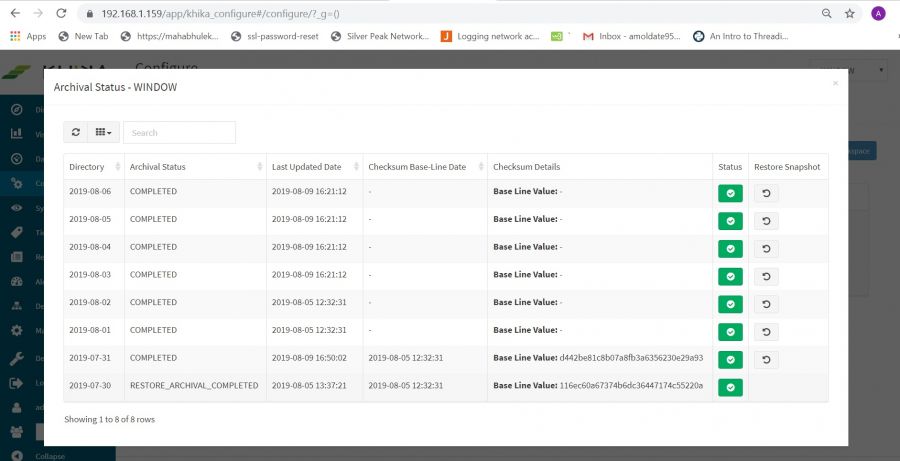
Above the screenshot, you will see the following columns
1. Directory
This show bucket date i.e index day that has been considered for Snapshot.
2. Last Updated Date
This shows last updated time to it’s corresponding state .
3. Checksum Base-Line Date
This shows the checksum baseline date of archival. When snapshot completed through its archival cycle then it’s checksum will be calculated. This help to identify data tampering (if someone tries to modify archival )
4. Checksum Modified Date
If baseline checksum modified then this column shows a date of modification.
5. Checksum Details
This column shows baseline checksum (old checksum) and new checksum (if checksum modified).
6. Restore Snapshot
This column shows action for the user if want to restore snapshot or cancel schedule for a restored snapshot.
7. Archival Status
This column shows the current status of the snapshot/bucket. Please see the following status of the snapshot
restore process (point a and point b)
Snapshot status
While taking snapshot there are some intermediate state which is given below.
NOTE: If there are any jobs with status “RESTORE_ARCHVAL_SCHDULED” Then script will give priority for restoration of the snapshot. User has to wait until all restored archival job to be finished.
1. SCHEDULED
SCHEDULED status means snapshot has been scheduled for that particular date.
2. INDEX_NOT_FOUND
Before scheduling snapshot utility check for index availability on that particular bucket day/date (according to TTL of the workspace). If index not found for that particular bucket day/date then it’s status mark as INDEX_NOT_FOUND.
3. IN_PROGRESS
This state means elastic snapshot is currently running.
4. SUCCESS
SUCCESS means snapshot finished and all shards were stored successfully.
5. FAILED
The snapshot finished with an error and failed to store any data.
6. COMPRESSING
After SUCCESS state of the snapshot, the COMPRESSING state comes into the picture. This state usually takes a long time for compressing.
7. COMPRESSED
After state COMPRESSING into the state will be COMPRESSED. It means that snapshot compressing done successfully.
8. COMPRESSING_FAILED
If something goes wrong while doing COMPRESSING snapshot then it states mark as COMPRESSING_FAILED.
9. MOVING_COMPRESSED_FILE
After state COMPRESSED if the user has configured to move archival snapshot to some offline/cold storage then it state MOVING_COMPRESSED_FILE appear while moving.
10. COMPRESSE_FILE_MOVED
Snapshot archival file move successfully to offline/cold storage.
11. COMPRESS_FILE_MOVE_FAILED
Failed to move COMPRESSED snapshot to offline/cold storage.
12. CHECKING_INTEGRITY
Checking integrity of snapshot archival. Here md5 checksum is calculated for archival.
13. CHECK_INTEGRITY_FAILED
This state means something goes wrong while calculating md5 checksum.
14. COMPLETED
After calculating md5 checksum successfully snapshot archival state mark as COMPLETED. This means the snapshot archival cycle has been completed.
Restore Snapshot status
There are some intermediate state while doing restoration of the snapshot which is given below.
If there currently any snapshot is running then the script will wait for to finish it and then restoration process will begin
1. RESTORE_ARCHIVAL_SCHDULED
This state means archival snapshot has been scheduled for restoration.
2. RESTORE_ARCHIVAL_NOT_AVAILABLE
This state means that snapshot archival not available on the designated location. This state specifies there is no way to restore the snapshot.
3. RESTORE_ARCHIVAL_COPYING
This RESTORE_ARCHIVAL_COPYING state means archival snapshot file is copying from offline/cold storage to registered snapshot repository location.
4. RESTORE_ARCHIVAL_COPY_FAILED
This state means failed to copy snapshot archival file from offline/cold storage to registered repository location.
5. RESTORE_ARCHIVAL_READY_TO_DECOMPRESS
This state means the snapshot archival file successfully copied from offline/cold storage to registered snapshot repository location.
6.RESTORE_ARCHIVAL_DECOMPRESSING
This state show that snapshot archival file is decompressing.
7. RESTORE_ARCHIVAL_DECOMPRESS_FAILED
This state means failed to decompress snapshot archival file. This may happen due to corrupt snapshot archival filename .
8.RESTORE_ARCHIVAL_INIT
RESTORE_ARCHIVAL_INIT snapshot restoration is in INIT state but not started.
10.RESTORE_ARCHIVAL_INDEX
This state means Reading index meta-data and copying bytes from source to destination.
11.RESTORE_ARCHIVAL_START
Restoration of the snapshot has been started.
12. RESTORE_ARCHIVAL_FINALIZE
Restoration has been done and doing some cleanup.
13. RESTORE_ARCHIVAL_DONE
Restoration of snapshot completed and data available to the user for searching and aggregation.
What to do if something goes wrong for snapshot restore functionality
Elasticsearch Snapshot utility raises an alert when it fails to take a snapshot.


